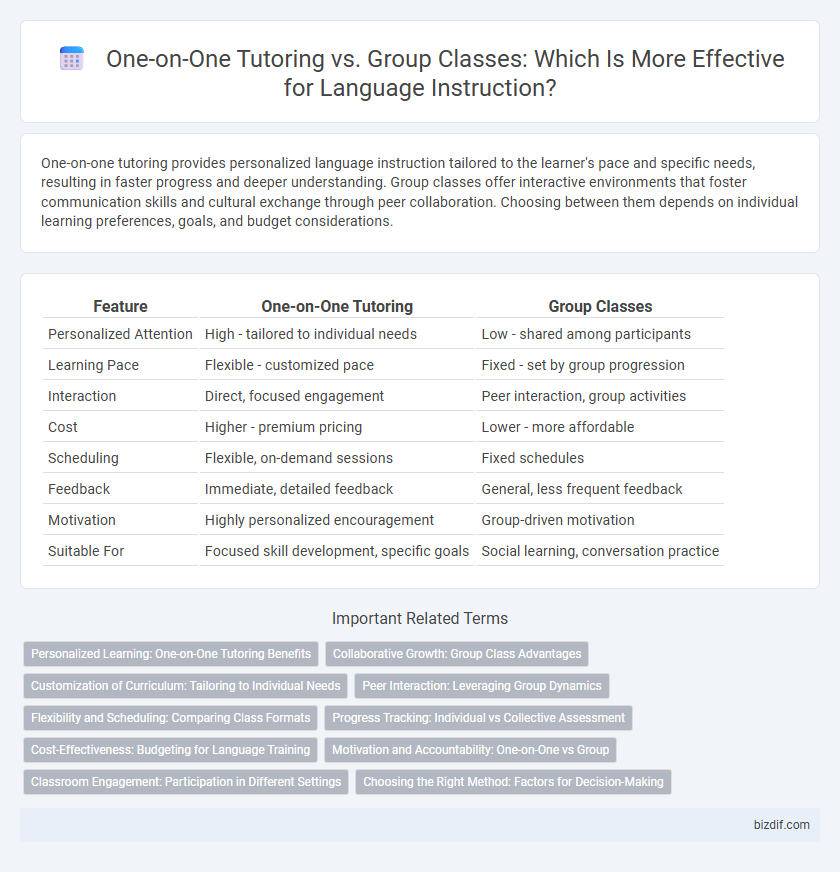One-on-one tutoring provides personalized language instruction tailored to the learner's pace and specific needs, resulting in faster progress and deeper understanding. Group classes offer interactive environments that foster communication skills and cultural exchange through peer collaboration. Choosing between them depends on individual learning preferences, goals, and budget considerations.
Table of Comparison
| Feature | One-on-One Tutoring | Group Classes |
|---|---|---|
| Personalized Attention | High - tailored to individual needs | Low - shared among participants |
| Learning Pace | Flexible - customized pace | Fixed - set by group progression |
| Interaction | Direct, focused engagement | Peer interaction, group activities |
| Cost | Higher - premium pricing | Lower - more affordable |
| Scheduling | Flexible, on-demand sessions | Fixed schedules |
| Feedback | Immediate, detailed feedback | General, less frequent feedback |
| Motivation | Highly personalized encouragement | Group-driven motivation |
| Suitable For | Focused skill development, specific goals | Social learning, conversation practice |
Personalized Learning: One-on-One Tutoring Benefits
One-on-one tutoring offers personalized learning tailored to individual student needs, allowing for customized lesson plans that address specific strengths and weaknesses. This focused approach enhances language acquisition by providing immediate feedback, promoting active engagement, and adapting to the learner's pace. As a result, students often achieve faster progress and greater confidence compared to group classes.
Collaborative Growth: Group Class Advantages
Group classes foster collaborative growth by encouraging peer interaction and diverse perspectives, which enhance language acquisition through real-time conversation and feedback. The social environment promotes motivation, accountability, and communication skills development as learners practice speaking with multiple partners. Exposure to varied accents and cultural insights in group settings enriches comprehension and cultural competence, speeding overall language mastery.
Customization of Curriculum: Tailoring to Individual Needs
One-on-one tutoring enables precise customization of curriculum, aligning lessons with a learner's specific language goals, pace, and proficiency level, which enhances engagement and retention. Group classes often follow a standardized syllabus designed to accommodate diverse skill sets, limiting personalized content and adaptive pacing. Tailoring instruction in one-on-one settings accelerates language acquisition by focusing on individual strengths and addressing weaknesses in real-time.
Peer Interaction: Leveraging Group Dynamics
Group classes enhance language instruction by fostering peer interaction, which accelerates speaking practice and cultural exchange through collaborative activities. Learners benefit from diverse perspectives and real-time feedback during group discussions, promoting deeper comprehension and motivation. Harnessing group dynamics creates an immersive environment that mimics natural language use, essential for fluency development.
Flexibility and Scheduling: Comparing Class Formats
One-on-one tutoring offers unparalleled flexibility, allowing students to personalize lesson times and adjust schedules based on their individual needs, which is ideal for busy professionals or those with unpredictable availability. Group classes typically follow a fixed schedule set by the institution, limiting the ability to tailor class times but providing a consistent routine that suits learners who benefit from structured environments. This difference in scheduling flexibility significantly impacts student engagement and progress, with private tutoring enabling more adaptive learning paths compared to the fixed format of group sessions.
Progress Tracking: Individual vs Collective Assessment
One-on-one tutoring offers personalized progress tracking, allowing for tailored feedback and adjustments based on the learner's unique strengths and weaknesses. Group classes rely on collective assessment methods, which may overlook individual performance nuances in favor of general class metrics. Personalized evaluation in one-on-one settings typically leads to more efficient language acquisition and targeted skill development.
Cost-Effectiveness: Budgeting for Language Training
One-on-one tutoring typically incurs higher costs per hour but offers tailored instruction that can accelerate language acquisition, making it cost-effective for learners with specific goals. Group classes provide a lower per-student fee, distributing expenses among participants, which benefits those on a limited budget seeking structured learning environments. Evaluating the total investment against personalized progress and learning preferences is essential for budgeting language training effectively.
Motivation and Accountability: One-on-One vs Group
One-on-one tutoring boosts motivation through personalized feedback and customized lesson plans that directly address a learner's strengths and weaknesses. Group classes foster accountability by encouraging peer interaction and collective progress tracking, which can inspire participants to stay committed. Choosing between the two depends on whether a student thrives with individualized attention or benefits more from social learning dynamics.
Classroom Engagement: Participation in Different Settings
One-on-one tutoring maximizes classroom engagement by enabling personalized interaction, immediate feedback, and tailored pacing that addresses individual learning needs. In contrast, group classes foster peer collaboration and diverse perspectives, yet might limit each student's active participation due to time constraints and varying proficiency levels. Effective language instruction balances the depth of one-on-one sessions with the dynamic social interaction found in group settings to enhance overall learning outcomes.
Choosing the Right Method: Factors for Decision-Making
One-on-one tutoring offers personalized attention, allowing instructors to tailor lessons to individual learning styles and pace, which can accelerate language acquisition. Group classes provide interactive environments that encourage communication practice and cultural exchange, benefiting learners who thrive on social engagement. Consider factors such as learning goals, budget, scheduling flexibility, and preferred interaction type to determine the most effective method for language instruction.
One-on-one tutoring vs Group classes Infographic

 bizdif.com
bizdif.com